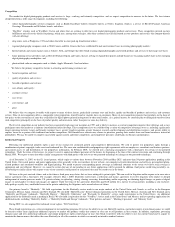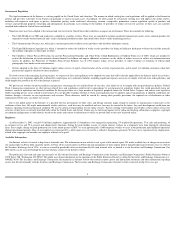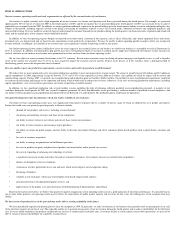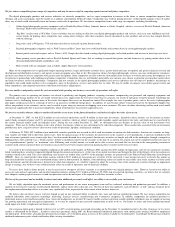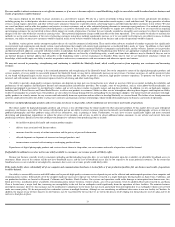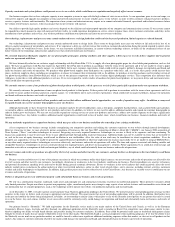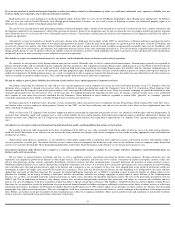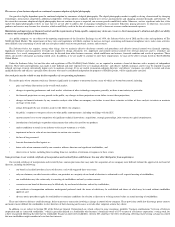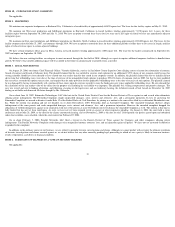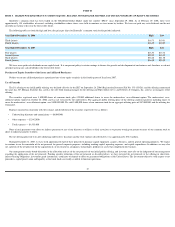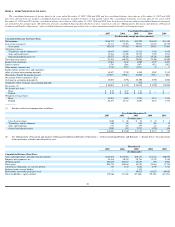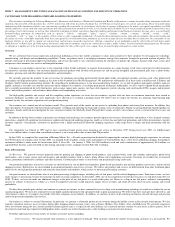Shutterfly 2008 Annual Report Download - page 20
Download and view the complete annual report
Please find page 20 of the 2008 Shutterfly annual report below. You can navigate through the pages in the report by either clicking on the pages listed below, or by using the keyword search tool below to find specific information within the annual report.
If we are unable to attract customers in a cost
-effective manner, or if we were to become subject to e-
mail blacklisting, traffic to our website would be reduced and our business and
results of operations would be harmed.
Our success depends on our ability to attract customers in a cost-
effective manner. We rely on a variety of methods to bring visitors to our website and promote our products,
including paying fees to third parties who drive new customers to our website, purchasing search results from online search engines, e-
mail and direct mail. We pay providers of online
services, search engines, directories and other website and e-commerce businesses to provide content, advertising banners and other links that direct customers
to our website. We also
use e-
mail and direct mail to offer free products and services to attract customers, and we offer substantial pricing discounts to encourage repeat purchases. Our methods of attracting
customers, including acquiring customer lists from third parties, can involve substantial costs, regardless of whether we acquire new customers. Even if we are successful in acquiring
and retaining customers, the cost involved in these efforts impact our results of operations. Customer lists are typically recorded as intangible assets and may be subject to impairment
charges if the fair value of that list exceeds its carrying value. These potential impairment charges could harm our results from operations. If we are unable to enhance or maintain the
methods we use to reach consumers, if the costs of attracting customers using these methods significantly increase, or if we are unable to develop new cost-
effective means to obtain
customers, our ability to attract new customers would be harmed, traffic to our website would be reduced and our business and results of operations would be harmed.
In addition, various private entities attempt to regulate the use of e-
mail for commercial solicitation. These entities often advocate standards of conduct or practice that significantly
exceed current legal requirements and classify certain e-mail solicitations that comply with current legal requirements as unsolicited bulk e-mails, or “spam.”
In addition, we have noted
unauthorized “spammers”
utilize our domain name to solicit spam. Some of these entities maintain blacklists of companies and individuals, and the websites, Internet service providers
and Internet protocol addresses associated with those entities or individuals that do not adhere to what the blacklisting entity believes are appropriate standards of conduct or practices
for commercial e-mail solicitations. If a company’s Internet protocol addresses are listed by a blacklisting entity, e-
mails sent from those addresses may be blocked if they are sent to
any Internet domain or Internet address that subscribes to the blacklisting entity’
s service or purchases its blacklist. From time to time we are blacklisted, sometimes without our
knowledge, which could impair our ability to market our products and services, communicate with our customers and otherwise operate our business.
We may not succeed in promoting, strengthening and continuing to establish the Shutterfly brand, which would prevent us from acquiring new customers and increasing
revenues.
A component of our business strategy is the continued promotion and strengthening of the Shutterfly brand. Due to the competitive nature of the digital photography products and
services markets, if we are unable to successfully promote the Shutterfly brand, we may fail to substantially increase our net revenues. Customer awareness of, and the perceived value
of, our brand will depend largely on the success of our marketing efforts and our ability to provide a consistent, high-
quality customer experience. To promote our brand, we have
incurred, and will continue to incur, substantial expense related to advertising and other marketing efforts.
Our ability to provide a high-
quality customer experience also depends, in large part, on external factors over which we may have little or no control, including the reliability and
performance of our suppliers and third-party Internet and communication infrastructure providers. For example, some of our products, such as select photo-
based merchandise, are
produced and shipped to customers by our third-party vendors, and we rely on these vendors to properly inspect and ship these products. In addition, we rely on third-
party shippers,
including the U.S. Postal Service and United Parcel Service, to deliver our products to customers. Strikes or other service interruptions affecting these shippers could impair our ability
to deliver merchandise on a timely basis. Our products are also subject to damage during delivery and handling by our third-party shippers. Our failure to provide customers with high-
quality products in a timely manner for any reason could substantially harm our reputation and our efforts to develop Shutterfly as a trusted brand. The failure of our brand promotion
activities could adversely affect our ability to attract new customers and maintain customer relationships, which would substantially harm our business and results of operations.
Purchasers of digital photography products and services may not choose to shop online, which would harm our net revenues and results of operations.
The online market for digital photography products and services is less developed than the online market for other consumer products. If this market does not gain widespread
acceptance, our business may suffer. Our success will depend in part on our ability to attract customers who have historically used traditional retail photography services or who have
produced photographs and other products using self-
service alternatives, such as printing at home. Furthermore, we may have to incur significantly higher and more sustained
advertising and promotional expenditures or reduce the prices of our products and services in order to attract additional online consumers to our website and convert them into
purchasing customers. Specific factors that could prevent prospective customers from purchasing from us include:
If purchasers of digital photography products and services do not choose to shop online, our net revenues and results of operations would be harmed.
If affordable broadband access does not become widely available to consumers, our revenue growth will likely suffer.
Because our business currently involves consumers uploading and downloading large data files, we are highly dependent upon the availability of affordable broadband access to
consumers. Many areas of the country still do not have broadband access, and the cost of broadband access may be too expensive for many potential customers. To the extent that
broadband access is not available or not adopted by consumers due to cost, our revenue growth would likely suffer.
If the single facility where substantially all of our computer and communications hardware is located fails or if our production facilities fail, our business and results of operations
would be harmed.
Our ability to successfully receive and fulfill orders and to provide high-
quality customer service depends in part on the efficient and uninterrupted operation of our computer and
communications systems. Substantially all of the computer hardware necessary to operate our website is located at a single third-
party hosting facility in Santa Clara, California, and
our production facilities are located in Hayward, California and Charlotte, North Carolina. Our systems and operations could suffer damage or interruption from human error, fire,
flood, power loss, insufficient power availability, telecommunications failure, break-
ins, terrorist attacks, acts of war and similar events. In addition, Hayward is located on, and Santa
Clara is located near, a major fault line, increasing our susceptibility to the risk that an earthquake could significantly harm the operations of these facilities. We maintain business
interruption insurance, however, this insurance may be insufficient to compensate us for losses that may occur, particularly from interruption due to an earthquake which is not covered
under our current policy. We do not presently have redundant systems in multiple locations, although we are considering an additional data center in our new facility in Charlotte. In
addition, the impact of any of these disasters on our business may be exacerbated by the fact that we are still in the process of developing our formal disaster recovery plan and we do
not have a final plan in place.
•
the inability to physically handle and examine product samples;
•
delivery time associated with Internet orders;
•
concerns about the security of online transactions and the privacy of personal information;
•
delayed shipments or shipments of incorrect or damaged products; and
•
inconvenience associated with returning or exchanging purchased items.
13



